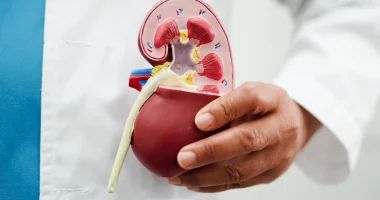Balanitis is when the tip of the clitoris or penis gets red and swollen because of an infection or something else. It might feel uncomfortable or hurt a bit, but it’s usually not a big problem. Signs include a tight pain or foreskin when peeing.
You can’t catch balanitis from someone else, but the infection causing it can spread. Here’s some info about balanitis:
- It usually happens in guys who aren’t circumcised.
- To treat it, doctors deal with what caused it, which helps stop it from happening again.
- It’s not a sexually transmitted infection (STI).
- Girls can get balanitis too, but this talks about guys getting it on the tip of the penis.
What is Balanitis?
Balanitis is when the tip of the penis, called the glans, gets swollen and red. This can happen because of a fungus, an infection, or something else.
Lots of guys get balanitis at some point. It affects around 3–11% of all guys at some time in their lives.
Sometimes, another problem called posthitis happens at the same time. Posthitis is when the foreskin gets inflamed. This combo, called balanoposthitis, affects about 6% of guys who aren’t circumcised. This condition only happens in guys who haven’t been circumcised.
Doctors often use the terms balanoposthitis and balanitis interchangeably because they’re so similar.
Symptoms
Balanitis comes with a range of symptoms and signs that can indicate its presence. These include redness around the penis, making it appear inflamed and irritated. Sometimes, the skin on the glans becomes shiny and feels tight. Additionally, there might be a noticeable foul smell accompanying the condition.
Another common symptom is experiencing discomfort due to a tight foreskin, which can cause soreness, irritation, or itchiness around the penis. In some cases, there may be a lumpy, thick discharge coming from beneath the foreskin, further indicating the presence of balanitis.
Pain during urination is another sign to watch out for, as well as the development of sores around the tip of the penis. Swollen glands near the penis can also occur in conjunction with these symptoms, indicating a potential case of balanitis. These varied symptoms collectively point towards the presence of this condition and warrant medical attention for proper diagnosis and treatment.
Treatment
Treatment options for balanitis vary depending on what’s causing it. It’s crucial for individuals experiencing symptoms to see a healthcare provider for an accurate diagnosis and appropriate treatment. Once the underlying cause is identified and addressed, balanitis typically resolves on its own.
Doctors may suggest several treatments for balanitis, including avoiding extreme cleaning of the genitals to prevent further irritation. They may also prescribe topical antifungal creams like miconazole, clotrimazole, or nystatin, or recommend oral antifungal medications such as fluconazole. In some cases, a combination of oral and topical antifungal treatments may be necessary. Additionally, applying low potency topical steroids or using a cephalosporin antibiotic might be part of the treatment plan.
In certain instances, circumcision may be recommended, especially for prevention purposes. While balanitis itself isn’t contagious, partners of individuals with balanitis should consider getting tested for Candida, a common cause of the condition. Starting treatment as a precautionary measure may also be beneficial for females. Consulting a healthcare professional is essential for determining the most effective course of action based on individual circumstances.
Types
Balanitis manifests in different forms, with three main types recognized:
Zoon’s balanitis
This type involves swelling affecting both the foreskin and the tip of the penis. Typically observed in middle-aged and older males who haven’t been circumcised, it’s characterized by redness and irritation in these areas.
Circinate balanitis
This variant of balanitis often occurs alongside reactive arthritis. It presents as small, painless lesions that emerge on the tip of the penis. While not necessarily uncomfortable, these lesions indicate the presence of the condition.
Pseudoepitheliomatous keratotic and micaceous balanitis
This type is distinguished by the appearance of scaly, wart-like injures on the tip of the penis. These lesions can be concerning and may require medical attention for proper diagnosis and treatment.
Understanding the different types of balanitis helps healthcare professionals tailor treatment plans to address specific symptoms and underlying causes effectively. If experiencing any symptoms associated with balanitis, consulting a healthcare provider is advisable for accurate diagnosis and appropriate management.
Home Remedies
While there aren’t any special things you can do at home to fix balanitis, keeping clean is super important to stop it from happening. Here’s what you can do:
- Wash your penis every day to keep it clean and healthy.
- Avoid bubble baths, using soaps, or anything with chemicals that might make it worse.
- After you pee, make sure to dry the area under your foreskin.
- Instead of harsh soaps, use gentle stuff that won’t irritate your skin.
These simple steps can go a long way in preventing balanitis and keeping your private parts feeling good.
Causes
Balanitis can happen for various reasons, each linked to different underlying conditions.
The common cause of balanitis is when the penis isn’t kept clean, especially if it’s uncircumcised. When guys don’t clean well, stuff like dead skin, sweat, and bacteria can build up, causing redness and swelling.
Another common cause is an infection with Candida albicans, which is a type of fungus that leads to thrush.
Several other things can also trigger balanitis, like:
- Bacteria: They love warm, moist places, like under the foreskin.
- Sexually transmitted infections (STIs): Herpes simplex virus, chlamydia, and syphilis are some examples.
- Skin conditions: Sometimes, conditions like eczema, psoriasis, lichen planus, or dermatitis can cause balanitis.
- Irritants: Certain chemicals, perfumes and detergents can irritate the skin, leading to balanitis.
Diagnosis
Diagnosing balanitis usually starts with a doctor taking a close look at the redness and swelling of the glans, which is the tip of the penis.
To confirm the diagnosis and figure out what’s causing it, the doctor will require to rule out the possibility of a sexually transmitted infection (STI) and pinpoint the underlying issue.
As part of the diagnostic process, the doctor might order some tests, such as taking a swab from the glans to check for any infections, doing a urine test to see if there’s any indication of diabetes, or conducting a blood test to measure glucose levels.
In rare cases, if the cause isn’t clear, the doctor might need to perform a biopsy. During a biopsy, they take a small sample of the inflamed skin and send it to a lab for further examination to get a better understanding of what’s going on.
Prevention
Preventing balanitis mainly involves keeping the penis clean and dry, which is super important. Guys should clean their penis every day, especially under the foreskin, to avoid buildup of stuff that can cause inflammation
If someone keeps getting balanitis, they might consider talking to a doctor about circumcision or figuring out what’s causing it to come back.
Here are some hygiene tips to help avoid balanitis:
- Pull back the foreskin to clean the head of the penis.
- Use warm water to gently wash the area, avoiding harsh soaps that can make it worse.
- A gentle, non-soap cleanser or aqueous cream can be used, but make sure to rinse it off completely.
- After washing, make sure the area is completely dry before putting the foreskin back.
- Guys who often get balanitis after sex should wash their penis after sex to keep things clean.
These simple steps can go a long way in preventing balanitis and keeping the penis healthy and happy.
Outlook
Treatment for balanitis aims to achieve a couple of important goals: first, to make sure everything works well in the private parts and when peeing, and second, to lower the chances of getting cancer there.
This often means treating whatever’s causing the problem or steering clear of things that could make it worse. With the right treatment, the symptoms usually get better.
After dealing with balanitis once, there are things a person can do to try to stop it from happening again.
Summary
Balanitis is inflammation of the penis caused by various factors like poor hygiene or infections. Diagnosis involves ruling out STIs and pinpointing the underlying issue, sometimes requiring tests or biopsies. Treatment aims to alleviate symptoms, reduce dysfunction, and lower cancer risk by addressing the root cause.
Maintaining good hygiene and avoiding irritants can help prevent future episodes. While there are no direct home remedies, cleanliness is crucial. Understanding balanitis and its causes empowers individuals to seek timely medical care and take preventive measures.
External links









